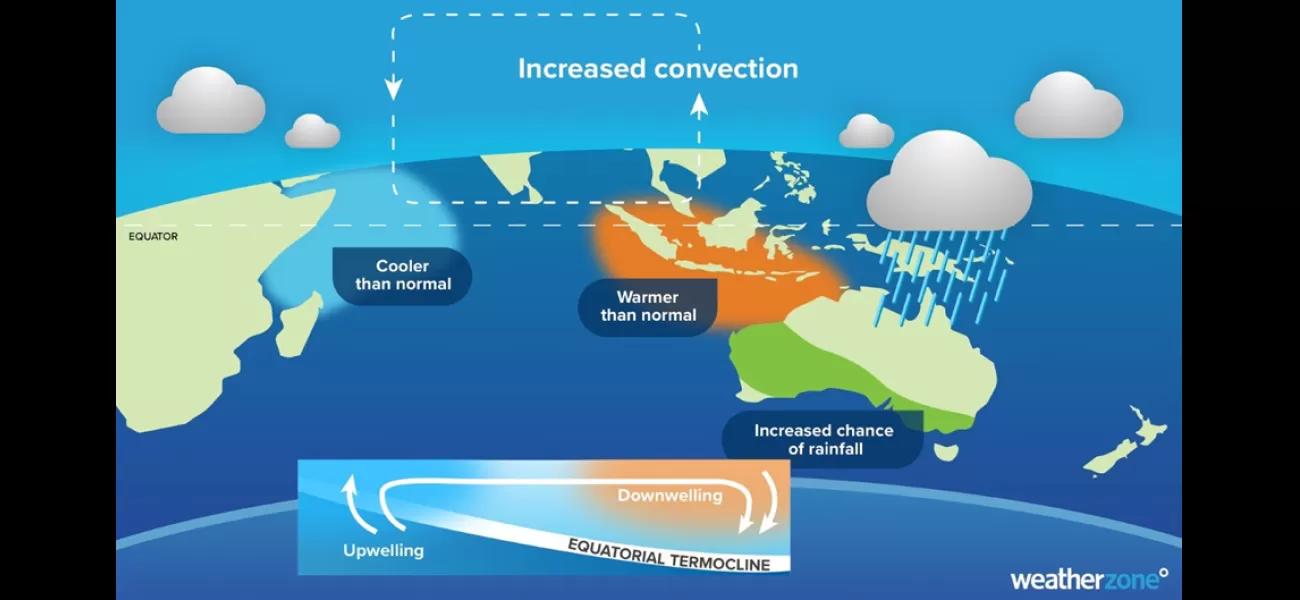This graphic suggests that Australia may experience a wet spring season.
The Bureau predicts increased precipitation due to a developing climate condition.
July 24th 2024.

Australia may experience a damp and rainy spring, as the Bureau of Meteorology has recently announced an increased likelihood of a negative Indian Ocean Dipole (IOD) in the upcoming months. This weather phenomenon would result in warmer ocean surface temperatures in the Indian Ocean, causing moist air to be drawn towards Australia.
When a negative IOD occurs, it typically brings above-average rainfall to the southern and southeastern regions of the country. This could have significant impacts on the weather during the winter and spring seasons, according to Weatherzone. The abundance of moisture in the air can create vast cloud bands in the northwest, bringing widespread rain, thunderstorms, and even potential flooding. On the other hand, it can also lead to below-average daytime temperatures, while nights may be warmer than usual due to the cloud cover trapping heat.
The Bureau of Meteorology would need to observe sea surface temperatures at -0.4 degrees or lower for eight consecutive weeks before officially declaring a negative IOD. "Phases of the IOD have influenced Australia's weather in recent years, with negative events occurring in 2021 and 2022, and a strong positive event in 2023," explains Weatherzone. Interestingly, this three-year period ties with 1996-1998 as the longest stretch of non-neutral IOD states recorded since 1960.
If a negative IOD develops in 2024, it would break this record and become the longest stretch of non-neutral IOD states in over 60 years of reliable data. As we eagerly anticipate the Paris 2024 Olympic Games, it's essential to keep an eye on these weather patterns as they may impact the events. You can catch every moment and every medal of the Olympic Games live and free on Channel 9 and 9Now, with ad-free and 4K coverage available on Stan Sport.
When a negative IOD occurs, it typically brings above-average rainfall to the southern and southeastern regions of the country. This could have significant impacts on the weather during the winter and spring seasons, according to Weatherzone. The abundance of moisture in the air can create vast cloud bands in the northwest, bringing widespread rain, thunderstorms, and even potential flooding. On the other hand, it can also lead to below-average daytime temperatures, while nights may be warmer than usual due to the cloud cover trapping heat.
The Bureau of Meteorology would need to observe sea surface temperatures at -0.4 degrees or lower for eight consecutive weeks before officially declaring a negative IOD. "Phases of the IOD have influenced Australia's weather in recent years, with negative events occurring in 2021 and 2022, and a strong positive event in 2023," explains Weatherzone. Interestingly, this three-year period ties with 1996-1998 as the longest stretch of non-neutral IOD states recorded since 1960.
If a negative IOD develops in 2024, it would break this record and become the longest stretch of non-neutral IOD states in over 60 years of reliable data. As we eagerly anticipate the Paris 2024 Olympic Games, it's essential to keep an eye on these weather patterns as they may impact the events. You can catch every moment and every medal of the Olympic Games live and free on Channel 9 and 9Now, with ad-free and 4K coverage available on Stan Sport.
[This article has been trending online recently and has been generated with AI. Your feed is customized.]
[Generative AI is experimental.]
0
0
Submit Comment





